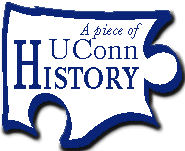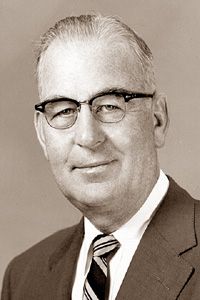This is an archived article. For the latest news, go to the Advance Homepage. For more archives, go to the Advance Archive/Search Page  | |||
|
Debate on freedom of speech
ushered in Jorgensen era The year 1935 began well for the more than 720 students of Connecticut State College. But before it was over, they would grieve for one mascot and greet a new one, face off with trustees over military training and free speech, and watch as one president resigned and another took office.
The new husky dog mascot arrived on campus at the end of 1934. As 1935 began, students were taking part in an Alumni Association contest to name the brown-and-white puppy. But, less than two months into the new year, on February 13, the dog died after being struck by a car. The day before the accident, the February 12, 1935, edition of the Connecticut Campus (then a weekly) reprinted an article from the Hartford Courant about an Alumni Association proposal to the General Assembly for increasing membership on the Connecticut State College board of trustees. The proposal called for a third alumni trustee and two new ex-officio members of the board: the commissioner of dairy and food and the state adjutant-general. Since 1931, there had been a growing movement on college campuses seeking the abolition of compulsory military training at land grant colleges and universities. To date, there had been little interest in the movement at Connecticut State College. When the proposal for the new trustees was made, however, a new campus organization known as the Social Problems Club "took up the fight against the bill," wrote Walter Stemmons in his history of the University's first 50 years. In March, the Connecticut Campus ran an editorial opposed to the measure, and reprinted similar editorials from two Hartford newspapers. "An atmosphere of unreality surrounded the plea at the legislative hearing that the adjutant general of the state be made ex-officio member of the board of trustees of Connecticut State College as a means of 'checking pacifism.' Even the sponsors of the measure in question presented little evidence of anti-militarism at the institution. They were 'thinking of the future,' " said editors of The Hartford Times. "The appointment of the adjutant general would constitute a criticism of the present control of opinion on the college campus," said The Hartford Courant. "Evidently the suggestion springs from a desire to see more military training and less freedom of expression at Storrs." The bill to add the new trustees failed - as did a follow-up bill requiring teachers to take a loyalty oath. But trustees of the college decided the public debate was getting out of hand. On April 17, they adopted a controversial measure, soon to be known as the gag rule. The measure stated "that military training is declared to be a part of college instruction. That any formal agitations or formal public discussion on campus promoted by individuals on the college staff, or individual students, which reflect upon the college military instruction or training, will subject such individuals to cause for removal." The reaction was immediate. A Campus editorial, titled "Mountain or Molehill?" chastised trustees, and raised questions about further erosion of free speech on campus. Faculty met in closed sessions April 29 and May 1, but word soon leaked that the discussions held in Beach Hall's Room 260 were about the gag rule. The matter brought a flood of national publicity and a delegation of students from more than a dozen other colleges and universities, including Columbia and Yale, drove to Hartford and then Storrs "to help students and faculty resist the edict of the board," said Stemmons. The delegation was not fully welcomed by students, who believed they could handle the matter themselves, he added. The Social Problems Club sponsored a program that included a talk by a Columbia student whose topic was "Fascism on Campus." It was held at Storrs Congregational Church - avoiding a direct violation of the gag rule. When a member of the audience suggested the speaker step across North Eagleville Road and repeat his remarks on campus, "This precipitated a near-riot and the student who made the suggestion was later doused in a nearby lake," reported Stemmons. In mid-May, trustees invited four student leaders to present their case. Trustees then voted on a resolution clarifying, but not reversing, the ban. Faculty were not invited to address the board and took offense. At the same board meeting, President McCracken submitted his resignation. It was accepted with regret by Gov. Wilbur Cross, who was attending as ex-officio president of the board. With the end of the semester and commencement in June, the controversy died down. But the board went to work immediately to find McCracken's successor, and the first issue of the Campus in the fall reported that on September 1, the trustees had hired a new president. When McCracken resigned, a May 21 Campus editorial had outlined what students hoped to see in a new president. One item stands out: "We believe that he should be young enough to spend 20 or 30 years with the college, during which time he would grow with the institution."
The words were prophetic. The trustees hired 36-year old Albert Nels Jorgensen, a mid-Westerner, who since 1931 had been a professor of education administration at the University of Buffalo. He arrived on campus in mid-October, and served for 27 years, presiding over massive changes in the academic program and campus infrastructure of what in 1939 would become the University of Connecticut. "Generally it was understood that repeal of the gag rule was one of the terms under which (Jorgensen) accepted office," wrote Stemmons. Yet when he took up his new post, he found it was not repealed and he called the board of trustees to a meeting. Two were absent, so he postponed the meeting for a week in order to have them all there. At noon on Oct. 26, Jorgensen announced to a special meeting of the faculty that the trustees had rescinded the gag rule the day before. The announcement was met with "vigorous applause," reported the Campus. In its November 12 issue, the paper reported on a community welcome held on campus to greet the new president and his wife. Also on page one of that issue was a story announcing the arrival of a white husky dog - Jonathan II. A new president and a new symbol of campus pride brought the tumultuous year of 1935 to a close and started a new era in the life of the college in Storrs. Mark J. Roy (Sources: various issues of the Connecticut Campus, 1934 and 1935; unpublished manuscript, Walter Stemmons. Materials available in the University's archive collection at the Thomas J. Dodd Research Center.) |


